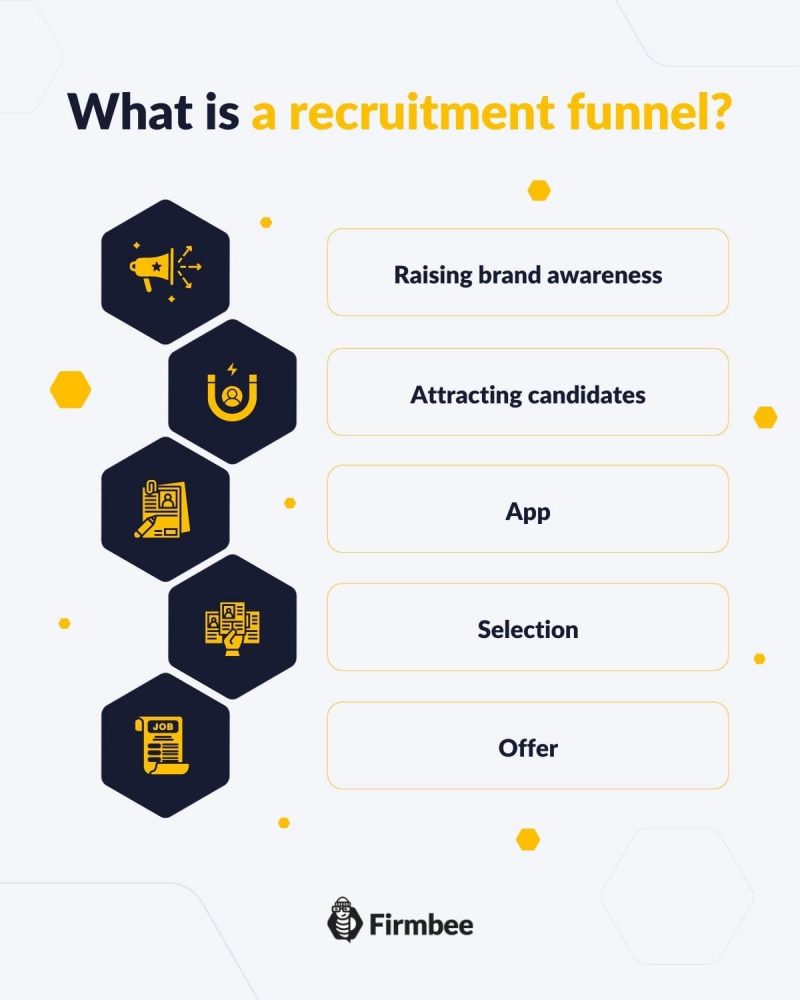What is a recruitment funnel and how does it help to evaluate recruitment performance? Read our article covering that issue and learn about the 5 levels of the recruitment funnel and associated performance metrics.
Recruitment funnel – table of content:
- What is a recruitment funnel?
- Raising brand awareness
- Attracting candidates
- App
- Selection
- Offer – the final stage of the recruitment funnel
- How to measure recruitment effectiveness?
- Check out our video about how to plan the recruitment process

What is a recruitment funnel?
The recruitment funnel is a model showing the consecutive stages of recruitment marketing and the recruitment process itself – raising awareness, attracting and stimulating interest among candidates, applications, the selection process and ultimately employment. At each of these levels, you can apply performance indicators to evaluate its effects.
Analyzing data from the recruitment funnel enables the recognition of the most effective areas of the process and highlights those that need improvement.
Raising brand awareness
The first step in the process of the recruiting funnel concerns marketing efforts that construct brand awareness not only among the company’s customers/users but also potential future employees. Based on your analysis of candidate demographics you can assess your candidate profile and find ways of reaching them entice them to work for your organization. Building a positive image in the marketplace, such as through a company blog, active management of social media channels, or collaboration with influencers will strengthen the company’s position and reputation in the marketplace.
It is also worthwhile to show the company and its workings from the inside using online media tools. Let the applicants and outsiders take a glimpse into its facilities, amenities, and perks. The main indicator of associated with this stage of this recruitment funnel include the number of views of your company career page and search results for your company website. This is the single evaluation of the effects of your marketing efforts and turn them into a coherent and arouse interest in your organization.
Attracting candidates
The second level of the recruitment funnel is attraction – that is, getting potential candidates interested in a specific offer. Depending on the industry, position and candidate profile to determine where and how you will advertise open recruitment processes. Remember to properly prepare a job description, the polished professional-written and well-formatted text with details relevant to the candidate.
Depending on your target audience, post your offers on social media groups, job portals or your career site. Regardless of the methods, reach candidates along with contact information along with so candidates can get in touch with you if they have additional questions or concerns. An indicator that can be measured at this stage is the conversion rate, which shows how many of the page viewers applied to the posted offer.
App
The application is the third level of the recruitment funnel that aims at verifying the marketing efforts of the previous stages. To ensure an influx of applications, make sure the application process is quick and efficient for the candidate – it shouldn’t take more than 10-15 minutes. Additionally, make your resume submission site compatible with mobile devices and send notifications that the application has been successfully submitted and received. To automate these processes, consider using ATS software available on the market. The conversion rate that we can measure at this stage is the verification of how many of completed the whole process.Its function is also to assess whether the application process have been efficient and at which stage candidates encountered difficulties and gave up.
Selection
The candidate selection process is the next level of the recruitment funnel. It begins with an initial selection of candidates based on their CVs, and then, depending on the chosen recruitment model, the recruiter conducts initial phone interviews, interviews and recruitment tasks until the most suitable candidate is selected for the position. Consider planning the whole process beforehand and inform the candidate about the number of recruitment termination deadlines.It is worth taking care of communication, informing candidates about the progress of the recruitment process, and providing feedback after each stage.
After the interviews, we can verify how many candidates participated in them, how many did not show up for the agreed interview, how many of them continued the recruitment process after each stage and how many resigned during the process. All these indicators allow you to assess the effectiveness of the recruitment process to improve it in the future. After the interview, it may also be useful to conduct surveys to assess the performance of the recruiter and the process from the candidates’ point of view.
Offer – the final stage of the recruitment funnel
The final decision and presentation of the offer of employment to the candidate is the last level of the recruitment funnel. The final selection of a candidate should take place shortly after the last stage of the recruitment interviews. Delaying the decision for too long may result in the candidate chosen by us changing his/her mind or receiving a job offer from our competitors. At this stage, negotiate the terms of the contract, such as salary, vacations, working hours and non-wage benefits. During the negotiations, you should remember the rules of employment in the company and the budget allocated for hiring a candidate. However, it is worth at least a few issues to go easy on the future employee, to build a relationship and an image of an attractive employer.
The indicator that evaluates the effectiveness of this stage is primarily time – determining how long this step took, how much time elapsed from the start of recruitment and from its various stages to the hiring of the employee.
How to measure recruitment effectiveness?
The recruitment funnel contains 5 separate stages. A specific set of performance indicators characterizes each and provides direct indicators of effective performance and points to required improvements and modifications in the future. In the first two stages of the recruitment funnel – building awareness and interest – you can measure the number of views of the company’s career site, analyze search results and measure the conversion rate. At the application stage, we can verify how many completed the process. After the interviews, it’s worth conducting surveys to measure the level of candidate experience and determine how many candidates attended and how many did not show up for the interview. Once you’ve gone through all the stages of the recruitment funnel, you can measure the duration of that stage and the time that elapsed between the start of recruitment and the hiring of the employee.
Observing the performance indicators in recruitment to the effects of marketing activities and the real interest in the organization on the labor market, verify whether the application process is efficient and at which stage the candidates encounter difficulties. The gathered data will ultimately allow you to evaluate the effectiveness of your recruitment process and hopefully improve it in the future.
Check out our video about how to plan the recruitment process:
Read: 4 HR problems which recruiters need to face
If you like our content, join our busy bees community on Facebook and Twitter.
Author: Nicole Mankin
HR manager with an excellent ability to build a positive atmosphere and create a valuable environment for employees. She loves to see the potential of talented people and mobilize them to develop.
The most important questions
-
What is a recruitment funnel?
A recruitment funnel is a model showing the successive stages of recruitment marketing and the recruitment process itself. It consists of 5 stages/levels.
-
What stages does the recruitment funnel consist of?
The recruitment funnel consists of 5 stages (levels). These are awareness, interest, application, selection and offer.
-
What is recruitment marketing?
Marketing activities related to building awareness among the company's clients and potential candidates, building the image of an attractive employer in the market, promoting current job offers
-
What indicators of recruitment effectiveness can you measure?
The number of views of the company's career page, search results for the company's page, conversion rates (e.g., how many people viewing the page completed it), and the number of candidates who attended the recruitment / did not show up for the scheduled interview / dropped out during the process.


















